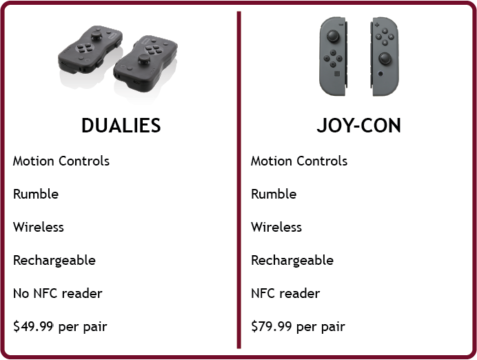
If there’s one undeniable truth about Nintendo, it’s that the company will sell you the best hardware that money can buy… but at a high price. Case in point, a pair of official Joy-Con controllers demands somewhere around $80. That’s a lot of money for most people, making it difficult to get hold of extra Joy-Con for games like Super Mario Party, where no other controller is compatible. Thankfully, Nyko has stepped in to offer fans an affordable alternative in the form of its new Dualies controllers. While some sacrifices had to be made in order to get the Dualies at a reasonable price point, these are still a very worthwhile and economical investment for gamers wanting some extra Joy-Con to play their games with.
So what separates Dualies from Joy-Cons? Let’s break down the differences:

As you can see, the only real difference in functionality between Dualies and Joy-Cons is that the former doesn’t have an NFC reader like the latter. There is another way that Dualies differ, however, in that they can’t be slid into the sides of a Switch like stock Joy-Con can. Dualies are entirely independent of the system in this regard and can thus only be charged using their included USB-C cable and must be connected wirelessly to the console.
As far as deal-breakers go, neither of these differences seem to fall into that category. In order to put this into proper perspective, it’s key to think about realistic usage of a Switch when weighing the decision to purchase some Dualies. For starters, every single Switch is sold with a pair of Joy-Con, which means that anyone who wants to play a Switch on the go is going to have those Joy-Con controllers that came with the system to slide down the sides. That said, people who want to play on the go but also have extra Joy-Con with them in case friends want to join in… well, whether you bring an additional pair of Joy-Con or Dualies, it isn’t going to impact that scenario either way. Any extra controllers are going to have be carried around separate from the Switch itself.
Insofar as powering up the units goes, as noted above, Dualies come with an external charging cable. Simply plug them into just about any wall charger and they’ll be good to go after a few hours. In regards to battery life, Dualies and Joy-Con both manage a similar, roughly 6-hour window of functionality before needing to be recharged. This will of course depend on how heavy the usage is for each controller, but on average that’s how long a given charge will last. In terms of usability, however, there’s an argument to be made that Nyko has, in some ways, outdone Nintendo when comparing the ease of use of a Dualie to a Joy-Con. The larger form factor of Dualies makes them far easier to grip and play with than a standard Joy-Con. The buttons tend to be easier to reach, as well. Throw in special grips to customize the control sticks and Dualies are both easy to play with and quite versatile.


While that’s a whole lot of praise, for sure, it’s also important to observe the shortcomings of Nyko’s Dualies. There’s no wall charger included with the controllers, just the USB-C cable. It’s also not possible to charge more than one Dualie at a time unless there are two USB-C cables and two wall chargers (or a double-socketed wall charger) present. This means that charge times for Dualies are effectively double Nintendo’s Joy-Con. That might not sound like a huge deal, but keep in mind that the more accessories that need to be purchased to balance out these deficiencies, the more it eats into that $30 difference in price that Dualies can boast about. Yet, with a little planning ahead, it’s easy enough to charge a pair of Dualies overnight in anticipation of a marathon session of Super Mario Party, for instance.
The only other downside to the Dualies is that the buttons on the controllers themselves aren’t quite as high in quality as those found on a Joy-Con. The difference is subtle, though, and might end up being more a matter of preference than anything else. For instance, HORI’s D-Pad Left Joy-Con has far spongier “minus” and “capture” buttons than a stock Joy-Con, but I actually like how they feel more than Nintendo’s own. In any event, what this all boils down to is that any negatives a Dualie has are far, far outweighed by their positives. They’re precise, they’re easier to play with, and they’re at a much more reasonable price point. NFC functionality isn’t included, nor can Dualies be clamped onto the sides of a Switch, but ultimately these controllers are made to be used for large multiplayer sessions, not a replacement for anyone’s original Joy-Con. Definitely give these some consideration when shopping for extra controllers!




 ShareThis
ShareThis





